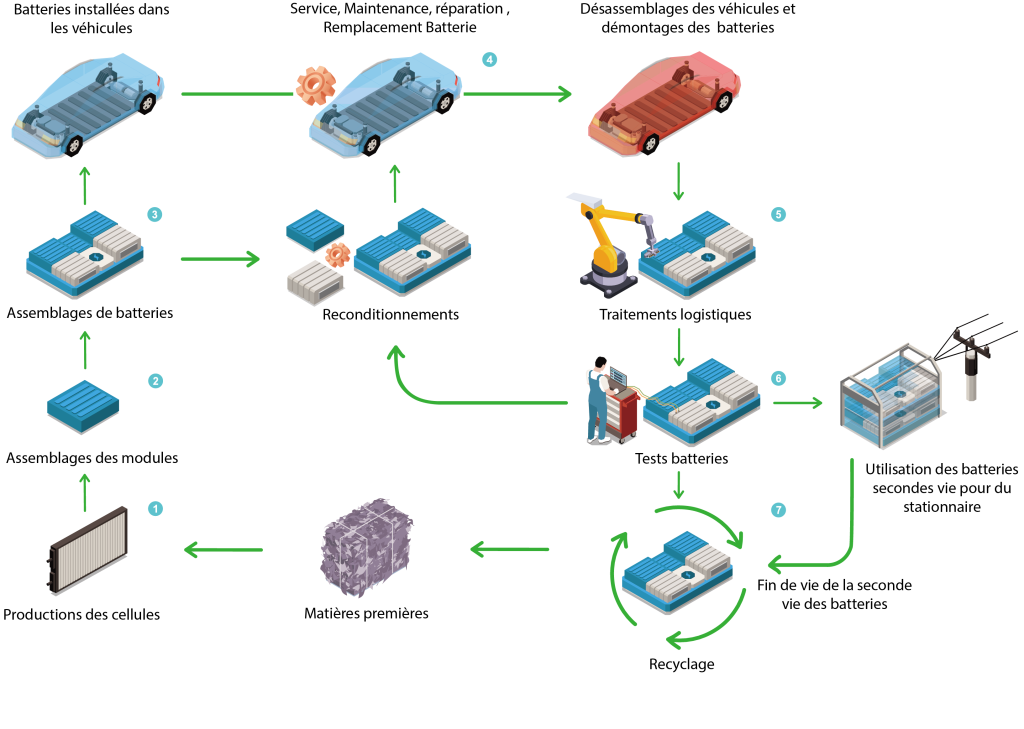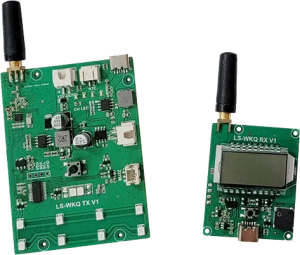Lithium-ion batteries play an important role in the climate and ecology as their production continues to increase. At the same time, their recycling is increasingly important due to the circular economy, life cycle safety and environmental impact. In addition, the European Union requires the use of recycled materials.

The biggest difficulty in recycling is to open lithium-ion batteries safely because the materials inside are very active and sensitive.

A burnt battery can still be dangerous and cause a fire later. (a). It will take a long and very protocolized process to make the battery inert (b). This part will be discussed later.
Our studies show that the best form of recycling is the one in which we have been involved for almost 10 years in China at Pro Lithium Shenzhen and the support of companies through prevention, equipment adapted to needs and protocols / operating methods.
This diagram below shows how lithium batteries should be oriented for better management and to avoid risks.
Let’s go back to the first part of recycling and the opening of the battery in Europe where pyrometallurgy is mainly used. The process is safe but it consumes a large amount of energy to be at high temperature. In addition, the furnace must be a large scale with recovery and treatment of gases emitted by exhaust during treatment (hydrogen fluoride for example). Remember that Lithium batteries are not bombs but accidents are often linked by air and gas produced by local overheating during comminution where the hydrogen generated by the reaction between water and the negative electrode or l ‘aluminum. It is therefore important to avoid the mixture of oxygen and hydrogen, nor concentrated organic gases.
Comminution in water or water spray deactivates the negative electrode and dilute the organic electrolyte. Note that the aqueous solution functions as a heat sink.
In non-immersed solution:

In summary, two methods are mainly used either by pyrometallurgy or by immersion in a solution (salt water, sulphate, lime water, etc.). Each solution has advantages and disadvantages: for pyrometallurgy considerable energy costs and hardly negligible pollution effects and for immersion in a solution a greater complexity for treatment.
The best way to respect ecology is to avoid risks and to work in a so-called responsible activity chain.
In the second part, we will discuss the solutions offered by Pro Lithium at the different stages of the Supply Chain.
Now let’s talk about prevention and supply chains with convincing results for the future of the Lithium battery
1- Production of Lithium Cells
The production of Lithium cells should be a priority even before talking about the battery assembly line because the production cost of the cell defines the market price Kw of the Lithium battery and secures the entire logistics chain. Producing cells makes it possible to have a stable market price, to guarantee the reliability of the cells and to progress in innovation by keeping control of the Lithium battery market. Pro Lithium based in France and China at the heart of the market is concerned to see that projects based around the recycling or assembly of batteries.
2-Module assembly
The modules meet the requirements of manufacturers using them for the assembly of their batteries and to date there is not really a standard in the nominal voltages used. From our experience in repairing Lithium batteries in the automobile, certain brands of cells such as LG Chem are much more present in vehicles (NMC prismatic cells) and it is much easier to access them by removing the battery.
In a critical point, the electrical harnesses used for the management of the modules by BMS are almost always different, not to mention the voltage and amperage that are never identical in a vehicle of a module from one manufacturer to another.
If the manufacturers were able to standardize their electrical harnesses and the voltage and amperage of the modules, this would facilitate the whole chain.
3- Battery assembly
For Lithium batteries intended for vehicles, we have noted for several years that the batteries on which we have intervened come mainly from Eastern Europe (Austria, Poland).
New factories are being set up in other countries such as France to carry out the assembly, but we remain very questionable about the KW price of the cell practiced if it comes from another continent?!
4-Maintenance and replacement of lithium batteries
From our experience of more than 10 years in China physically and by our Pro Lithium structure not very far from the factory BYD car manufacturer, it would be difficult not to realize the general mastery of their Supply Chain. Producing their own cells for their vehicles, they master the entire repair chain and even further. Batteries are becoming more standardized to the point where Tesla in China uses BYD cells.
To return to Lithium batteries on electric vehicles in Europe, we repair them quite easily with our equipment and are generally able in 2 days to give a second life to the user who returns the battery to us. To date, there are too few repair points in France, whereas we would like to accompany them so as not to imagine immediately recycling but rather to seek to repair.
Suitable equipment makes it possible to revitalize a car battery by working on it and repairing it. We support professionals in all of these services: design, development of equipment and training in the use of these machines.
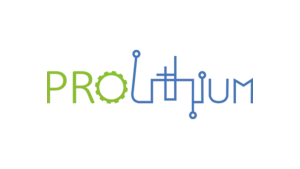 Pro Lithium offers its solutions to Lithium battery professionals and those who would like to become one.
Pro Lithium offers its solutions to Lithium battery professionals and those who would like to become one.
5- Logistics processing
The logistics of Lithium batteries is not simple and we advise you to read the regulations in force on our website here.
 We offer solutions that meet European Union regulations, directives and compliance
We offer solutions that meet European Union regulations, directives and compliance
6 Battery Tests for Reconditioning and Reuse
Despite what we often hear, the second life of a battery is something difficult to standardize and yet it should be done in order to facilitate this market which makes it possible to considerably reduce the very polluting and energy-consuming recycling discussed in the first part ” pyrometallurgy”.
To give a second life to a battery generally it is necessary to connect a new BMS or BMU + CMU if we start from several modules. The BMS or BMU / CMU must be programmed for the new use that the modules will make by taking all the characteristics of the cells inside the modules (by making simple the voltage, the amperage the limits of charges and discharges will be taken taken into account and then integrated into the BMS or BMU/CMU settings.
If the language becomes too technical see also the article “nomenclature” available here.
To give a battery a second, several operations are essential, such as:
- Cell testing
- Cell balancing
-BMS or BMU/CMU setting depending on cells and battery usage the bms will be different.
-Battery assembly
7 Recycling end-of-life batteries that cannot be used.
This branch is the last of the whole Supply Chain and not the second after the assembly of the battery. It is important to distinguish the physical, chemical and usable states of the battery to confirm the recycling of batteries according to their classification.
We can classify a lithium battery according to different criteria:
- Dangerousness
- Battery SOH
- Cell type see topic here
See here all the solutions offered by Pro Lithium
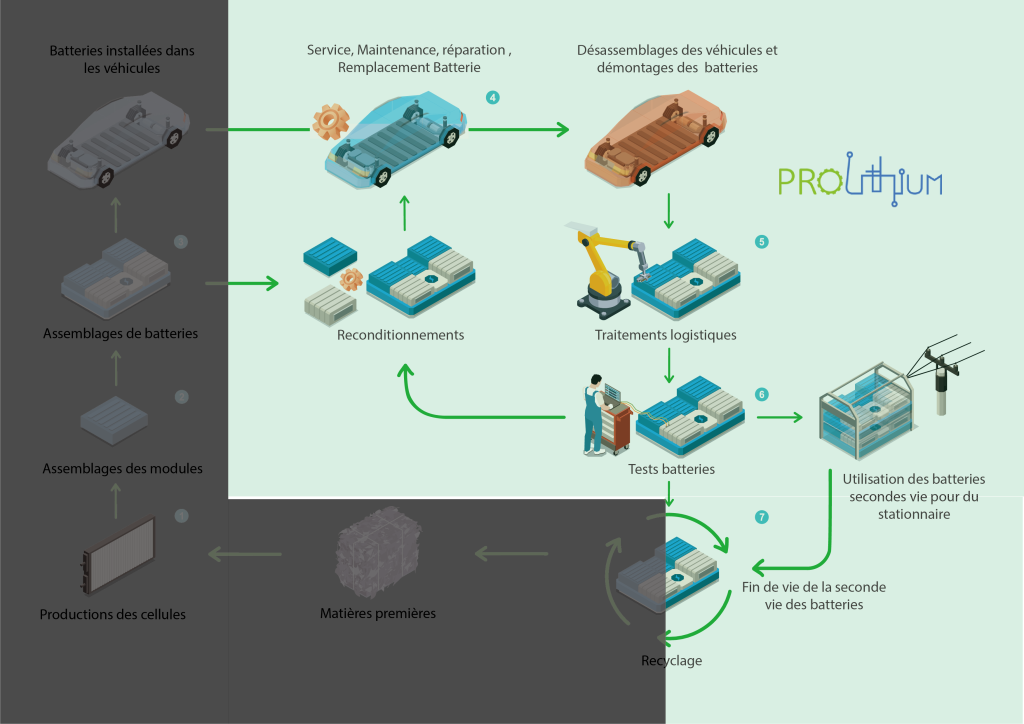
4-Maintenance and replacement of lithium batteries
Pro Lithium designs electronic equipment dedicated to battery diagnostics and their reuse. We develop equipment allowing the reuse of modules without having to worry about their voltages and amperages. We support professionals in the settings, uses and equipment for the production of stationary batteries.
5- Logistics processing
We have developed equipment to monitor and trigger fire slowing or even shutdown mechanisms in the event that this occurs. See the article here
6 Battery Tests for Reconditioning and Reuse
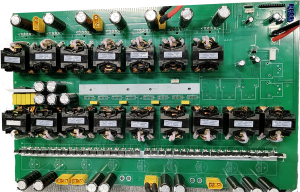
Pro Lithium has developed equipment that allows any battery and module from a vehicle to be used in stationary applications without having to deal with charge and discharge voltages and limits.
Pro Lithium has developed innovative equipment to reuse cells from recycling in a new product see here.
7 Battery recycling at end of seconds and cannot be used.
Pro Lithium has been offering for 2 years a line allowing the separation of materials in order to reduce the risk of fires in logistics and in order to recover the material. This line is made up of equipment to reduce the voltage below 0.3V before material separation, an air treatment station and several crushers separating the materials.
In conclusion
Our services are linked to the recovery of batteries after assembly and during their second life by integrating them into new functions using equipment that we have and have been developing for several years.
Companies interested in investing in a future activity for the lithium battery can send us an e-mail by clicking here
For services, training, equipment needs in all the things mentioned click here
We intervene to enhance the second life, recycling and repair with our equipment and our know-how.

